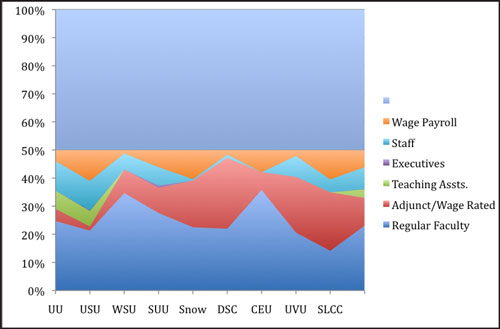CEU tops in number of full-time faculty
The majority of classes at the College of Eastern Utah are taught by full-time tenure and tenure-track instructors; a feat many colleges in the United States cannot claim because it is more economical to hire adjuncts in place of full-time instructors. Almost 72 percent of its instructors are full time, compared to 28 percent of full-time instructors at Salt Lake Community College.
Weber State University follows CEU with 69 percent of its faculty being full time and Southern Utah University bolstering 55 percent of its faculty as full time.

This archived article was written by: The Eagle
The majority of classes at the College of Eastern Utah are taught by full-time tenure and tenure-track instructors; a feat many colleges in the United States cannot claim because it is more economical to hire adjuncts in place of full-time instructors. Almost 72 percent of its instructors are full time, compared to 28 percent of full-time instructors at Salt Lake Community College.
Weber State University follows CEU with 69 percent of its faculty being full time and Southern Utah University bolstering 55 percent of its faculty as full time.
On the bottom side of the spectrum, five Utah colleges use full-time instructors to teach at least 40 percent of their classes. Those schools include Utah Valley University 41 percent, Utah State University 43 percent, Dixie State College 44 percent, and Snow College 45 percent, according to the Utah System of Higher Education Data Book.
The U of U has 1,172 full-time instructors and 510 adjunts followed by USU with 622 full-time instructors, 205 adjuncts; WSU has 486 full-time instructors, 117 adjuncts; UVU has 402 full-time instructors, 387 adjuncts; SLCC has 325 full-time instructors, 481 adjuncts; SUU has 218 full-time instructors, 77 adjuncts; Snow has 126 full-time instructors, 93 adjuncts; DSC has 94 full-time instructors, 108 adjuncts.
CEU has 91 full-time instructors and 16 adjuncts. The faculty taught 2,920 contact hours, a total of 2,030 instructional credit hours offered with students taking 21,853 credit hours.
Sixteen faculty members from CEU taught overload classes (more than 15 hours of class instruction) with 91 part-time instructors teaching classes fall semester. Those 16 instructors taught 87 contract hours to students while the adjuncts taught 612 contract hours of instruction.
Part-time instructors generate 22 percent of CEU’s total FTE (full-time equivalent) with instructors teaching overload classes, generating three percent of the total FTE.
Michelle Fleck, academic vice president and provost, adds, “It’s difficult for CEU to find qualified adjuncts, due to our rural location. Ideally, adjuncts who teach general education courses should hold a masters in the discipline. This matter is on our curriculum and instruction committee agenda for this semester (minimum qualifications for adjunct faculty).”
In the Chronicle of Higher Education on Nov. 14, 2008, Peter Schmidt wrote, “At a time when colleges are under increasing financial pressure to rely more on part-time instructors, three new studies suggest that doing so erodes the quality of education many students receive.
“Part-timers’ inability or unwillingness to devote more time to students outside the classroom, the research suggests, results in the denial of important support services to many students – including, often, those who need the most help.
“And in a finding that breaks new ground, one of the studies concludes that heavy reliance on part-timers can actually hurt the performance of full-time, tenure-track faculty members. One possible explanation: Full-timers feel less secure at institutions that might replace them with part-time instructors and lecturers, said that study’s author, Paul D. Umbach, an associate professor of adult and higher education at North Carolina State University.”
Part-timers are not the ones to blame, Umbach said, “We are not treating these faculties in a way that they are feeling valued.”
In a Dec. 4, 2008 article in The Ithacan online, Norah Shipman wrote, “Recent studies done at North Carolina State University and the National Education Association report students receive a lower-quality education with adjuncts and part-time faculty as opposed to full-time faculty.”
The Rocky Mountain News reports in Jan. 22, 2007, “Under heavy budget pressure, the state’s colleges and universities are increasingly delegating teaching duties to part-time employees – called ‘adjuncts’ – who are hired for a single course, or to instructors who earn far less than professors and do not enjoy the job protection of tenure.
School leaders say part-timers bring real-world experience to practical courses in engineering, business, education or journalism, balancing the more theoretical approach of full-time faculty.
“But they do not relate to students in the same way as traditional professors, says Metropolitan State College of Denver President Stephen Jordan.
“‘I can remember the times that we would go from class back to the department offices and sit down and talk with faculty,’ Jordan said of his days as an undergraduate at the University of Northern Colorado. ‘When we don’t have full-time faculty, we deprive (students) of one of the most important parts of the collegiate experience.’
“Connecting students with traditional professors during their freshman and sophomore years could reduce Metro’s high drop-out rate, Jordan said. Metro loses 38 percent of its students during their freshman year.
“Fewer than 40 percent of Metro courses are taught by traditional faculty members, and many Metro students don’t see an actual professor until their junior year.”




